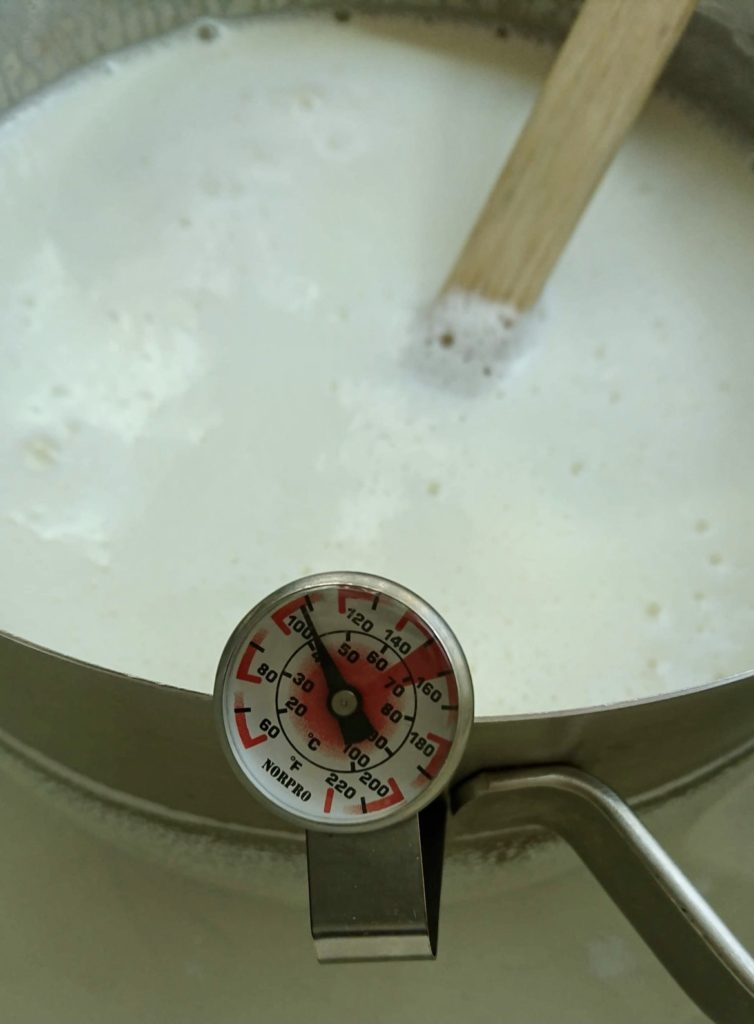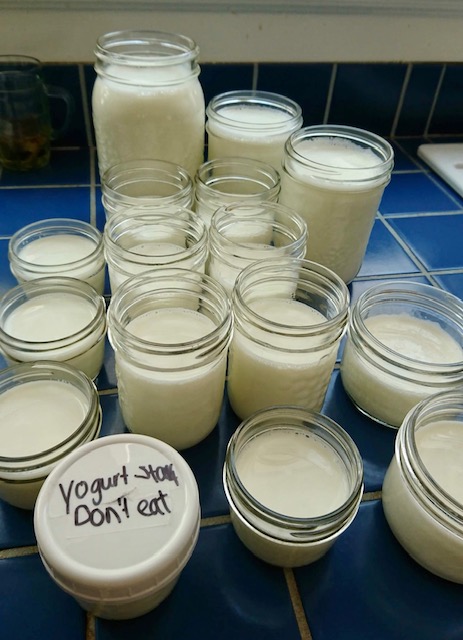When I ask people here in the USA what typical Dutch things are, they normally think of tulips, famous painters, mills, how nice people are, how beautiful Amsterdam is, wooden shoes and smoking pot. And sometimes they will say cheese. The Netherlands is one of the most important export countries to ship Dutch dairy products. But what are typical Dutch dairy products?
Crafty Dutch Girl is Reader-Supported. When you buy through links on our site, we may earn an affiliate commission. Learn more.
A little bit of history
Since the pre-historic times, the Dutch have been making cheese. It probably didn’t taste like the cheese we know now, but just the fact they knew then, you could make cheese out of milk. The reason that the Dutch had cows for a long time, is that the soil was not dry enough to grow wheat or any other crop than grass. And what to do with grass? Let the cows eat it to make wonderful milk.
In the middle ages the Dutch transported cheese to other countries in Europe.
From 1880 on, many cheese factories opened up and corporations were formed to establish strong trade products for other countries. During this period, cheese and butter were the main trading products.
There is a beautiful museum in Friesland all about agriculture where you can see more of the history of the dairy industry in the Netherlands.
A few interesting facts about Dutch Dairy

Cheese
Dutch cheese is one of a kind and hard to find or make yourself for that matter, outside of the Netherlands. And if you have found Dutch cheese, it is expensive, because the export costs will be included.
In the Netherlands I loved the “Graskaas” which is the very young cheese (less than 4 weeks old). Very soft and hard to slice. I found young Gouda cheese at Costco and they have “Amsterdammer”as well, which is an old cheese (10-12 months old). The older the cheese is, the harder and more yellow, the sharper and nuttier the taste will be. If you ever wondered what Gouda or Edam means, these are cities in the Netherlands where the original cheeses were made.

Nowadays you’ll find all kinds of cheeses at the local (cheese) markets with add ins like cloves, pepper, cumin and chili peppers. Most of the Dutch people eat their cheese on a sandwich. The thing I love a lot is “het Kaasplankje”, a cutting board with different cheeses (usually cut small in bite size pieces), other sliced smoked ham, olives and bread. This together with a good glass of wine or beer…yes, please!!
Butter
The other day I wanted to make something (forgot what it was) from a Dutch recipe and it asked for “roomboter” (literally: cream butter). I was wondering what the difference was between the butter in the USA and that particular kind of butter. Most of the Dutch dairy butters come in a container with lid. These are mostly the spreadable butters for sandwiches. “Roomboter” is the product of churned cream of milk. The name butter can only be used when it contains 80% milk fat.
Margarine and “halvarine” are actually fake butters. In the USA a lot of butters come in a pack with 4 sticks of 1/2 cup each, which is very handy for baking. Then they have also butters in containers and some of them are called “I can’t believe it’s not butter”.
The industrial butter production only started in the late 1800’s. Before that, the farmer and his family were eating this byproduct of livestock farming. But because of economic growth, the need for dairy products grew as well.
How to make butter?
It’s actually not hard to make butter. I always do it accidentally when I want to make whipped cream and I whip it a little too long.
I remember going on vacation in Austria where we (I was 10 years old) stayed at a really old farm in the mountains. The living space was in the front of the farm and the cows were in the back of the farm. Every morning we ate fresh rolls from the local bakery, with fresh made butter and honey.
- Use raw milk (where you can see the fat or cream on the top) or start with the cream.
- Churn the cream, by shaking it in a mason jar for example or in a churn, like this.

- The butter starts to separate from the milk (“karnemelk” or “buttermilk”) in lumps.
- Knead the butter in water to get the rest of the buttermilk out. Then salt the butter and you’re done.
Here is a fun little video how people use to make butter on the farm.
Milk and milk powder
As I mentioned before, milk powder is one of the most exported Dutch dairy products. It easy to export, because the expiration date is of course longer than fresh milk.
In general the Dutch want to know where the milk they drink comes from. The more local, the better. Campina is one of the most famous brands of dairy products in the Netherlands. They guarantee that all their sources are in the Netherlands and that the cows get 120 days, 6 hours a day outdoor time.
But for better deals, some grocery stores in the Netherlands combine Dutch milk with milk from other European countries. Not that other countries have bad milk, but people need to know where the milk comes from, because it doesn’t always say on the package.
We are so lucky to have a local farm with a German farmer in our small town in Iowa. The milk is amazing and it just tastes like the milk in Europe!
Yogurt and “vla”
So, here it is! The Dutch dairy products Mieke and I miss the most is yogurt, quark and “vla”.
Usually the yogurt in the Netherlands is more sour. I always had a hard time eating the Dutch yogurt straight out of the container. I added fresh fruit, granola and sometimes for a quick fix, fruit syrup (which is another thing that’s hard to find here in the US).
In the last few years I lived in the Netherlands, I found a smoother and softer yogurt version, which is called “Biogarde”. The mild taste comes from the added bacteria lactobacillus acidophillus and the lactobacillus bifidum.
How to make yogurt at home?
According to Mieke, it is very easy to make yogurt yourself. Here is what she does. You just need:
- a big pot
- a food thermometer
- 1 gallon of milk
- 1/2 cup yogurt (the only time you need to buy yogurt)
- small jars with lids
- oven
1: Heat up the milk in the pot to 183 F (84C).

2: Let it cool to 108F (42C).

3: Add the 1/2 cup of plain yogurt (this contains the probiotic culture) to the lukewarm milk. Stir until it is dissolved.
4: Preheat the oven just for 1 minute to raise the temperature just a couple degrees. Divide the milk in the small jars. See tip 2 below.

5: Turn off the oven, but leave the light on. This warmth will generate enough heat so it helps the probiotics to flourish. After 8-12 hours your yogurt is done and can be moved to the fridge.
Some extra tips:
Tip 1: Always keep some yogurt safe from your hungry family members by labeling one jar clearly! This will be your starter for the next batch.
Tip 2: I use different sizes of containers and leave a little room for fresh fruit, maple syrup or granola to add in the morning for breakfast or pop it in the lunch boxes for the kids.

You never have to buy yogurt again!
Kwark or Quark
One of my favorite cakes or pies is the “kwarktaart”, which is made with quark. Unfortunately, this is also one of those ingredients which is hard to find in America. The difference between quark and yogurt is that quark is technically a kind of cheese, because of the added rennet in the process.
Recipe for “kwarktaart” without quark!
This recipe is based on this strawberry “kwarktaart” from Marieke, but instead of using gelatin I used agar agar powder (or flakes), because my husband is vegetarian and gelatin is animal based. Instead of speculaaskruiden, I used pumpkin spice and added more cinnamon to it.
For the crust:
- 1 tbsp pumpkin spice plus 1 tsp cinnamon
- 7 tbsp (100 gram) butter
- 8 tbsp (60 gram) custard powder
- 5 tbsp (60 gram) sugar
- 8 tbsp (60 gram) of flour, can be gluten free flour as well.
For the filling:
- 18.3 oz vanilla yogurt or strawberry yogurt
- 250 gram strawberries and more for garnish
- 8.5 oz (250 ml) heavy cream (1/2 pint should be good)
- 6 sheets of gelatin or 9 gram of agar-agar flakes or powder if you want to make it vegetarian.
- 2 tbsp (25 gram) sugar
- 1 1/3 tbsp (25 gram) powder sugar
- 1 1/3 (25 gram) cornstarch
Step 1: Preheat oven to 350 F.
2: Grease the sides of a spring form cake pan. Line the bottom with parchment paper.
3: Mix all the ingredients for the crust with your hands and push gently on the bottom of the cake pan. Use the back of a spoon if needed.
4: Bake the crust for about 25-35 minutes. Let cool!
5: Dissolve the gelatin sheets in cold water. Squeeze out the sheets. Blend the strawberries in a blender. In a pot heat the strawberries and sugar. Add the gelatin or if you use agar-agar powder or flakes, just add to the strawberries and sugar without dissolving in water first.
6: Heat slowly and stir. Little by little add the yogurt and cornstarch. Let the mixture cool.
7: Whip up the heavy cream with the powder sugar.
8: When the strawberry mixture cooled down, fold in the whip cream.
9: Spread the strawberry-whip cream mixture in the cake pan and leave it in the fridge overnight. Garnish with strawberries.
Vla or pudding
Finally the last Dutch dairy product is “Vla”. “Vla” comes in all kinds of flavors. It is more like a pudding, but in the Netherlands you can buy it in a carton. I personally liked the “blanke vla”, but when I was pregnant with our oldest, I ate a ton of the vanilla vla.
To make vanilla vla, you can try this recipe:
Ingredients:
1 vanilla bean (or 1 tsp vanilla extract)
1 3/4 cup (400 ml) milk
1/2 cup (100 ml) heavy cream
6 egg yolks
6 tbsp (75 gram) sugar
I hope these are some useful tips and recipes for you to try. Let us know if you have any wonderful tips, recipes or ideas you use in your kitchen!!!

Hello everyone,
Welcome to my Crafty Dutch Girl blog! Grab a cup of “koffie” and browse through fun blog posts about our Dutch family expat life in the USA, Dutch history, Dutch recipes, Dutch things to do in the USA and all kinds of crafts and activities. Don’t forget to connect with me for new ideas! “Groetjes en tot ziens”.


ik hou van de gemengde vla aardbei en vanilla mm mm mmmm
Ik ook! De blanke vla vind ik ook lekker. Ik denk dat ik de volgende keer in Nederland de kinderen… Read more »